Victorian Era Exhibition at Earl’s Court
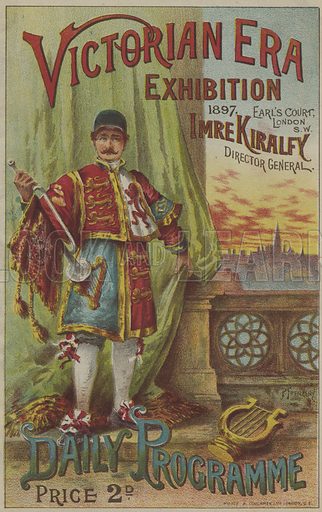
The Victorian Era Exhibition was held in Earl’s Court in August, 1897. It marked the 60th anniversary of Queen Victoria’s accession to the throne on June 20, 1837. Queen Victoria was the first British monarch ever to celebrate a Diamond Jubilee. The Exhibition The catalog was so large that it was published in several sections: fine art, historical/commemorative, women’s work, music/drama, and scientific/industrial/commercial/economic sections.
The “incubator baby” exhibition at Earl’s Court in 1897 followed immediately on the heels of the Berliner Gewerbeausstellung (Berlin Industrial Exhibition) in 1896, and is (to my knowledge) the first documented attribution of such an exhibit to Dr. Martin Couney (see links to Lancet articles below). He staged the exhibit with his associate Samuel Schenkein (spelling varies when he’s mentioned elsewhere), a New York entrepreneur, and Mme. Louise Recht, an experienced nurse who trained in the Paris Maternité. Unable to find physicians locally to provide babies for the exhibit, Couney and Recht transported infants from Paris by cab, train, and steamer, in wicker baskets. In later years, Couney claimed to have been responsible for the incubator exhibit at the 1896 Berliner Gewerbeausstellung, but contemporary accounts of that exhibit attribute it to Alexandre Lion.
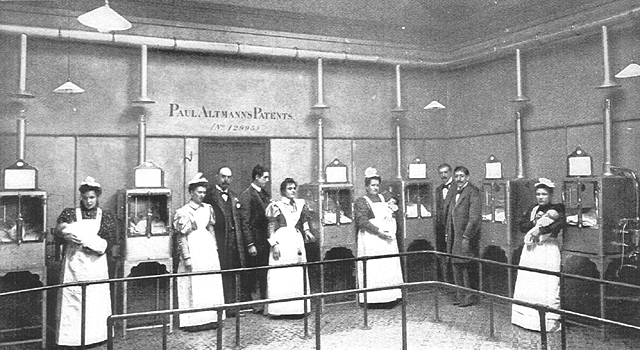
According to the Lancet and contemporary photos (see above), the Earl’s Court exhibit used incubators built by Paul Altmann of Berlin. These appear to be identical to the Lion Incubator and were presumably built under license using Dr. Alexandre Lion’s design and patent. According to Claire Prentice’s research, the exhibit was located across from the Welcome Hall and was visited by 3,600 people on the first day, B y the end of the summer, some 207,000 people had seen the incubator babies. Among the luminaries who visited the exhibit was Baron Rothschild and the famous Shakespearean actress Ellen Terry.
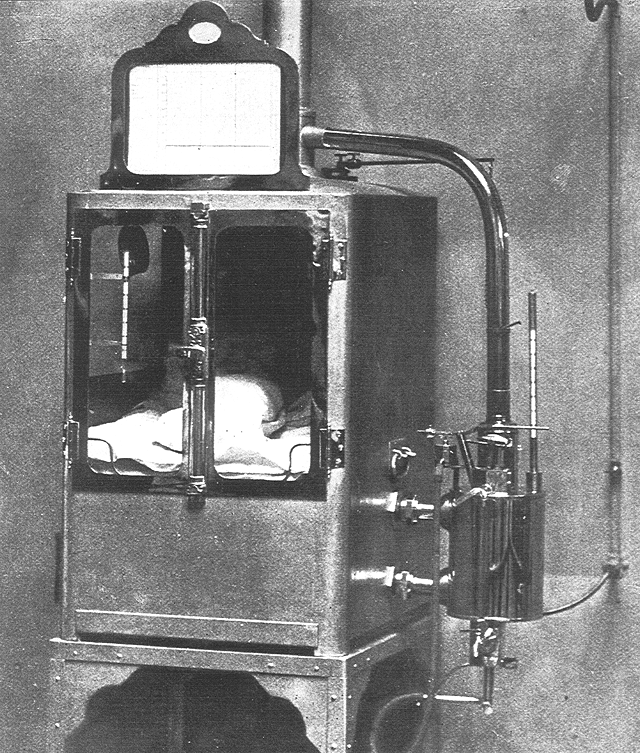
The incubator exhibit received widespread coverage in the medical press.
“On Monday members of the press were invited to a private view of the incubators for infants at the Victorian Era Exhibition, Earl’s-court. These are exhibited in a building facing the Welcome Club, and divided into three compartments. On one side there is sleeping accommodation for two wet nurses and for Mdlle. Louise Recht, who has been specially trained at the Paris Maternity Hospital to look after debilitated and prematurely born infants reared in incubators. A special service for this purpose was established at the Maternité in 1893, and here some 400 children, born under most unfavourable circumstances, are received annually. On the other side of the building there is a nursery, where the infants are taken to be fed and washed. The public are admitted to the central room, and here they can view the infants lying within the incubators, and are shown how the apparatus is ventilated and warmed and the temperature automatically maintained. The mechanism employed for this purpose has already been fully explained in these columns. [1] Its efficiency is now put to a practical test. Messrs. Coney and Schenbein, who are the representatives in England of this the “Altmann Incubator,” invite the criticism of the medical profession, and will supply every possible facility for the fullest investigation. They are ready to take in their charge any prematurely born child, and, apart from the trained nurse and the wet nurses, they have retained the services of two physicians, who attend three or four times a day to watch over the health of the infants. At night the watchman awakes the nurses every three hours so that they may feed the infants, and in the day time the babies are fed, generally from the breast, every two hours. In the nursery there is a small pharmacy, contrivances for sterilising milk, ingenious feeding bottles, and scales so that the infants may be weighed and their progress daily observed. A very large number of persons have already visited this exhibit, including many trained nurses. Much interest is manifested by the visitors. The incubators and the ventilating tubes are silvered, which gives them a bright and cheerful appearance, while the infants within look clean and comfortable, so that altogether it is a pleasant as well as an interesting sight.” –– The Lancet 2:161-162, July 17, 1897.
The clippings below are from the popular press and the exhibit catalog.
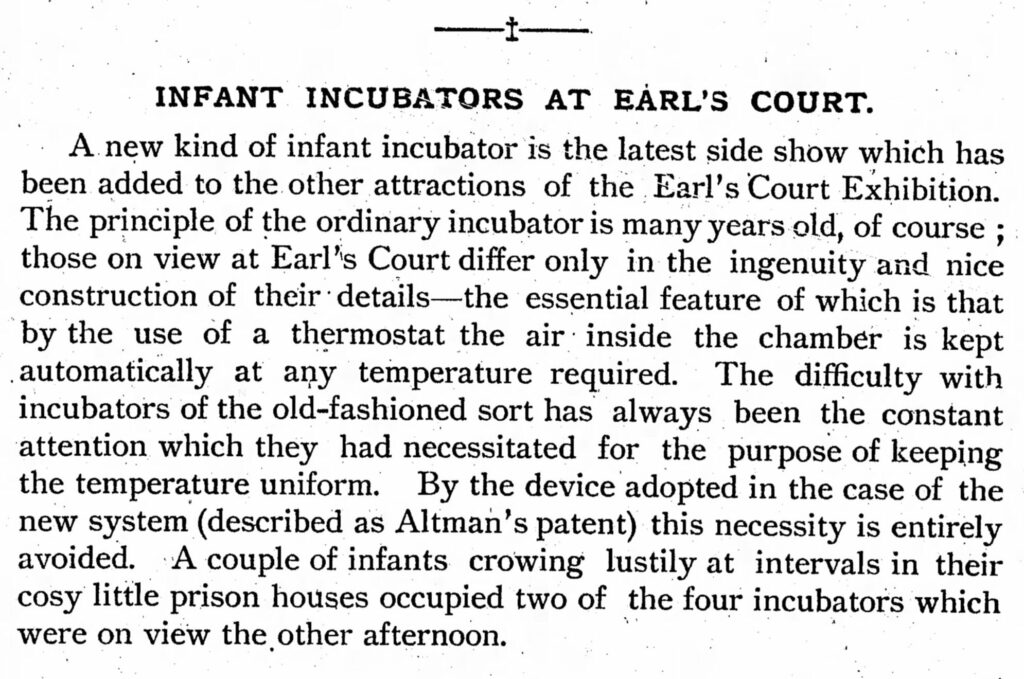
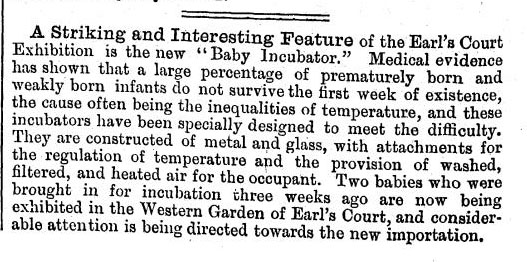
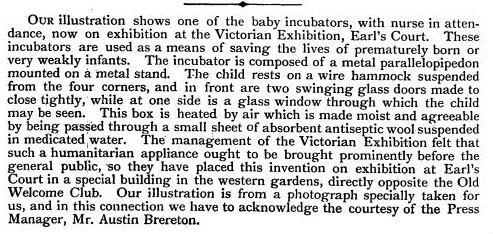


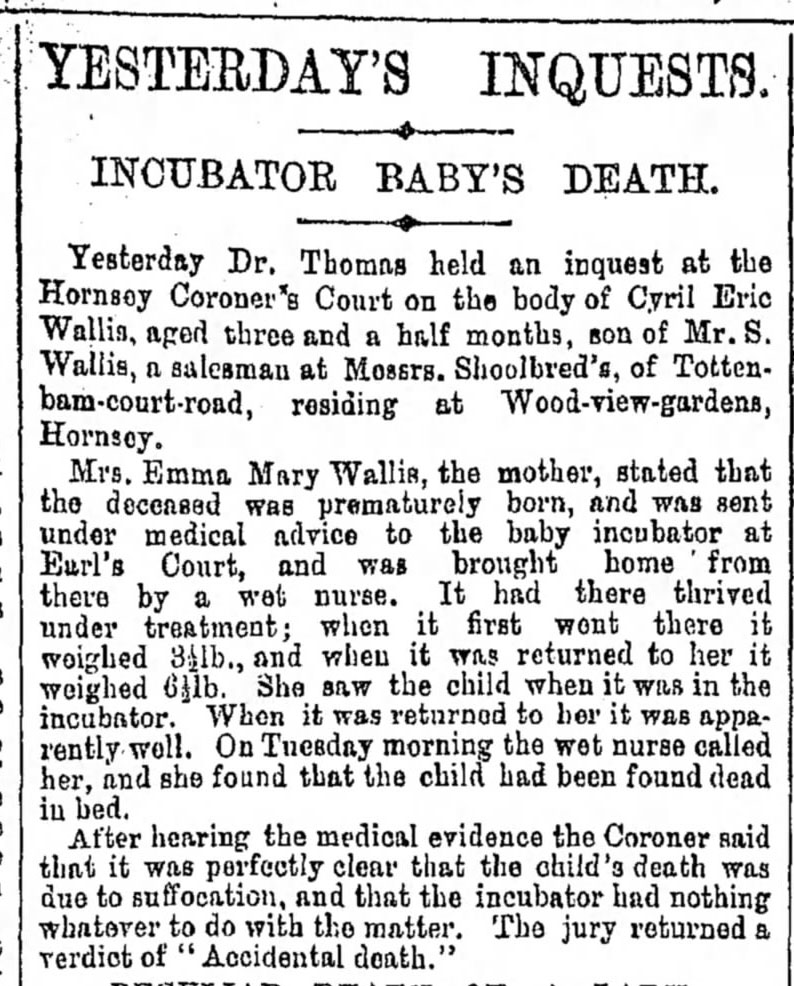
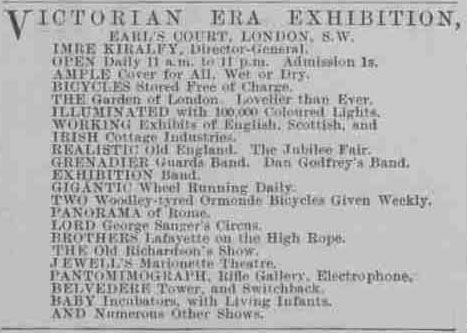
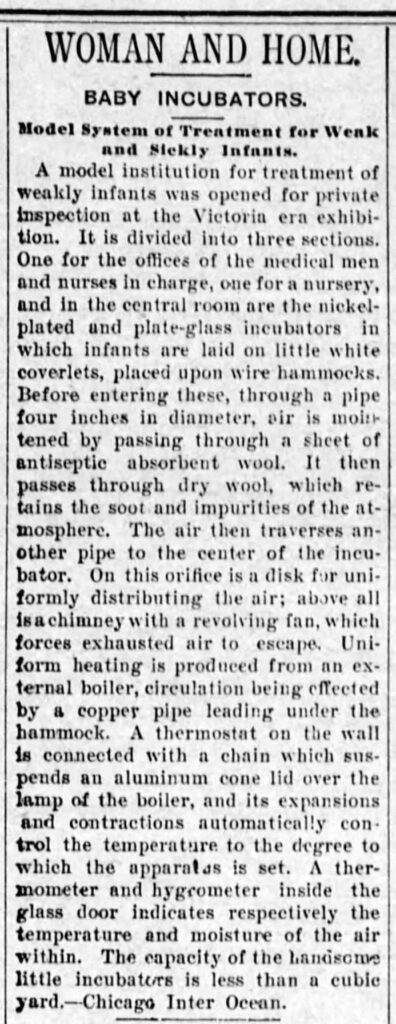

- “The Use of Incubators for Infants,” The Lancet, May 29, 1897.
- “The Victorian Era Exhibition at Earl’s Court,” The Lancet, July 17, 1897.
Martin Arthur Couney
- Short biography of Martin Couney
- Martin Couney, Wikipedia
- Martin Couney’s Obituary, from The New York Times, March 2, 1950.
Martin Couney Exhibits in World’s Fairs and National Expositions
- Victorian Era Exhibition at Earl’s Court, 1897
- Trans-Mississippi Exposition, Omaha, 1898
- Pan-American Exposition, Buffalo, 1901
- Lewis and Clark Exposition, Portland, 1905
- Panama-Pacific International Exposition San Francisco, 1915
- Century of Progress International Exposition, Chicago, 1933-34
- New York World’s Fair, New York, 1939-1940
Martin Couney Sideshows in Amusement Parks
- Coney Island Sideshow at Luna Park
- Coney Island Sideshow at Dreamland
- Lakeside Amusement Park, Denver.
- Luna Park, Pittsburgh
- Wonderland – Minneapolis and St. Paul
- Wonderland – Revere Beach
- Boardwalk – Atlantic City
- White City Amusement Park – Chicago
- White City Amusement Park, Indianapolis, Indiana
- White City Amusement Park, Cleveland, Ohio
Recent Books
- The Strange Case of Dr. Couney, by Dawn Raffel, Blue Rider Press, ISBN 0399175741
- Buy on Amazon (your purchase will support “Neonatology on the Web”)
- Miracle at Coney Island, by Claire Prentice (Kindle or audiobook)
- Buy on Amazon (your purchase will support “Neonatology on the Web”)
General Articles
General articles about Martin Couney and his exhibits are linked below. Additional links may be found in specific posts about his participation in expositions or sideshows.
Keep in mind that many of these were written before the full facts about Martin Couney’s background became known, or have not incorporated that new information, so they include information from his self-invented background legend.
- Incubator Baby Sideshows, by William Silverman, from Pediatrics.
- Postscript to Incubator-Baby Sideshows, by William. Silverman, from Pediatrics
- Martin Couney’s Story Revisited, by AAP Perinatal Section Ad Hoc Committee on Perinatal History, from Pediatrics
- Martin Couney’s Obituary, from The New York Times, March 2, 1950.
- A Patron of the Premies, by A. J. Liebling, from The New Yorker
- The Coney Island Baby Laboratory, by Gary R. Brown, from American Heritage Invention and Technology Magazine
- American Characters: Martin Couney, by Richard Snow, from American Heritage Magazine
- The Man Who Ran a Carnival Attraction… by Claire Prentice, from Smithsonian Magazine
- Life under Glass, audio documentary by Claire Prentice, from the BBC
- Martin Couney and Incubator Exhibits from 1896 to 1943, from the Embryo Project
- The Incubator Baby and Niagara Falls, by Arthur Brisbane, from The Cosmopolitan
- Babies on Display, from NPR
- Beginner’s Luck, from Family Circle Magazine 1993
- Coney Island’s Incubator Babies, by Rebecca Rego Barry, from JSTOR Daily
- The Infantorium, by Katie Shornton, from 99% Invisible
- How One Man Saved a Generation of Premature Babies, from BBC News
- Baby Incubators: From Boardwalk Sideshow to Medical Marvel, by Erin Blackmore, from History.Com
- Babies in Sideshows, by Julie Andreson, from Engines of our Ingenuity
- Dr. Martin Couney, from Coney Island History Project
- “The Use of Incubators for Infants,” The Lancet, May 29, 1897.
- “The Victorian Era Exhibition at Earl’s Court,” The Lancet, July 17, 1897.
- Incubator Baby Shows: A Medical and Social Frontier, by Hannah Lieberman, from The History Teacher 35.1, November, 2001.
- The Child Hatchery, from City Pages.
- Good Old Coney Island, by Edo McCullough, excerpt from the book
Last Updated on 11/23/25